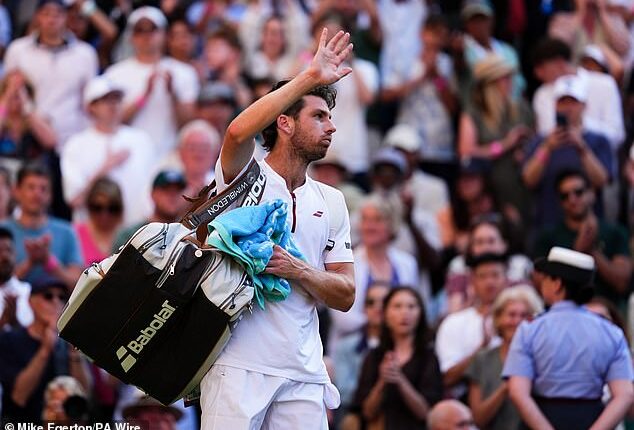Cam Norrie’s Wimbledon campaign is over after he was annihilated by the genius of Carlos Alcaraz in the quarter-finals.
The Spaniard won 6-2, 6-3, 6-3 to tee up a semi-final against American Taylor Fritz. The 22-year-old from Murcia is on a mission to become the fifth man to win this title three years in a row, the others being Bjorn Borg, Roger Federer, Novak Djokovic and Pete Sampras.
Such is his majesty on this surface, it is no exaggeration to say we may look back on Alcaraz as the best of the lot.
What of Norrie’s ability to get under the opponent’s skin, as he did in defeating Nicolas Jarry to reach this stage? In the third set Norrie tried blasting the ball directly at Alcaraz, who reacted with the speed of a viper to hit a volley winner.
In the first game of the match there was a ‘C’mon’ directed straight down the court towards his rival but Alcaraz is a difficult man to rattle; he is just having too much fun. This was s***house against s***hot.
It was difficult, watching this, to fathom the fact that Norrie has actually won two of their previous meetings, on the clay of Rio de Janeiro and a hard court in Cincinnati. But this is grass and, curiously enough, it is Alcaraz’s best surface.

Any hope of British winner at this year’s Wimbledon Championships went up in a puff of smoke on Tuesday as Cameron Norrie suffered a rapid straight-set defeat against Carlos Alcaraz

He lost the first set of his quarter-final against the Spaniard (above) after a mere 28 minutes

Alcaraz was just too good for Norrie as he swept the Brit aside 6-2 6-3 6-2 on Centre Court
When he emerged, he himself claimed to favour hard courts and we assumed – given nationality – that he would be a clay specialist. But after a couple of years to acclimatise he has assembled a stunning resume on the lawns: his win percentage of 92 per cent is the highest in the Open Era.
He has looked shaky at times this fortnight but this was a complete performance and Alcaraz will be a significant favourite to take out Fritz – who beat Russian Karen Khachanov in four sets – and reach the final.
Norrie was not helped by the atmosphere on Centre Court. None of Wimbledon’s arenas are exactly bearpits but Norrie has talked much this fortnight of his ability to feed off the energy of No1 Court, where he has played and won three straight matches.
He has won nine of 10 on that court and now one of six on Centre. It was far from full at the start, as fans took a breather after the three-set battle between Aryna Sabalenka and Laura Siegemund. And even when it filled up, it felt like the patrons were too awe-struck by Alcaraz’s brilliance to produce much noise for his opponent.
Could Norrie have done any more, anything differently? Well, it is important when facing a demi-God like Alcaraz to give them a chance to show their mortal side. As tempting as it is to come out guns blazing, feeling like you have to do something special to win, you must first test the waters of the opponent’s game.
Alcaraz has been sloppy at times this fortnight – especially in being taken to five sets by Fabio Fognini in the first round – with his forehand wayward. He did miss a couple early on but Norrie made a frantic start: his tally of three unforced errors in the first two games was the same as in the entirety of the first set in his fourth-round win over Nicolas Jarry.
Norrie played a ragged third game, conceding the break with a double fault, and from there Alcaraz clicked into cruise control.
Easy to say, almost impossible to do, but Norrie could have had more success by focussing on dragging out the rallies.

Bukayo Saka (right) and Jurrien Timber (left) watch on as Norrie faces off against Alcaraz


Norrie was the last Brit standing after exits from the likes of Jack Draper and Emma Raducanu

Fans flocked to Wimbledon’s famous Henman Hill to watch Norrie take on Alcaraz on Tuesday
There was something admirable but rather tragic about Norrie’s enthusiastic fist pumps. Born competitor that he is, he was probably the only one on Centre Court who still believed he had a chance.
To run through a few of Alcaraz’s best shots. There was an extraordinary rally at the start of the second set in which Alcaraz hit in succession: backhand pass, a disguised lob, curving smash, forehand approach, angled backhand volley at full stretch.
A ridiculous jumping forehand pass to earn a second break of serve; it looked to be flying long but he had applied so much work on the ball that it dropped on to the line.
A drop volley on game point which he hit with such insouciance that he did not break his stride as he walked to the chair. Allied to the delicacy of his touch is terrible power: his is a velvet fist in an iron glove.









